
The S.T.E.P.S. To A Healthier Heart
10almonds is reader-supported. We may, at no cost to you, receive a portion of sales if you purchase a product through a link in this article.
Stepping Into Better Heart Health

This is Dr. Jennifer H. Mieres, FACC, FAHA, MASNC. she’s an award-winning (we counted 9 major awards) professor of cardiology, and a leading advocate for women’s heart health. This latter she’s done via >70 scientific publications, >100 research presentations at national and international conferences, 3 books so far, and 4 documentaries, including the Emmy-nominated “A Woman’s Heart”.
What does she want us to know?
A lot of her work is a top-down approach, working to revolutionize the field of cardiology in its application, to result in far fewer deaths annually. Which is fascinating, but unless you’re well-placed in that industry, not something too actionable as an individual (if you are well-placed in that industry, do look her up, of course).
For the rest of us…
Dr. Mieres’ S.T.E.P.S. to good heart health
She wants us to do the following things:
1) Stock your kitchen with heart health in mind
This is tied to the third item in the list of course, but it’s a critical step not to be overlooked. It’s all very well to know “eat more fiber; eat less red meat” and so forth, but if you go to your kitchen and what’s there is not conducive to heart health, you’re just going to do the best with what’s available.
Instead, actually buy foods that are high in fiber, and preferably, foods that you like. Not a fan of beans? Don’t buy them. Love pasta? Go wholegrain. Like leafy greens in principle, but they don’t go with what you cook? Look up some recipes, and then buy them.
Love a beef steak? Well we won’t lie to you, that is not good for your heart, but make it a rare option—so to speak—and enjoy it mindfully (see also: mindful eating) once in a blue moon for a special occasion, rather than “I don’t know what to cook tonight, so sizzle sizzle I guess”.
Meal planning goes a long way for this one! And if meal-planning sounds like an overwhelming project to take on, then consider trying one of the many healthy-eating meal kit services that will deliver ingredients (and their recipes) to your door—opting for a plants-forward plan, and the rest should fall into place.
2) Take control of your activity
Choose to move! Rather than focusing on what you can’t do (let’s say, those 5am runs, or your regularly-scheduled, irregularly attended, gym sessions), focus on what you can do, and do it.
See also: No-Exercise Exercise!
3) Eat for a healthier heart
This means following through on what you did on the first step, and keeping it that way. Buying fresh fruit and veg is great, but you also have to actually eat it. Do not let the perishables perish!
For you too, dear reader, are perishable (and would presumably like to avoid perishing).
This item in the list may seem flippant, but actually this is about habit-forming, and without it, the whole plan will grind to a halt a few days after your first heart-health-focused shopping trip.
See also: Where Nutrition Meets Habits!
4) Partner with your doctor, family, and friends
Good relationships, both professional and personal, count for a lot. Draw up a plan with your doctor; don’t just guess at when to get this or that checked—or what to do about it if the numbers aren’t to your liking.
Partnership with your doctor goes both ways, incidentally. Read up, have opinions, discuss them! Doing so will ultimately result in better care than just going in blind and coming out with a recommendation you don’t understand and just trust (but soon forget, because you didn’t understand).
And as for family and friends, this is partly about social factors—we tend to influence, and be influenced by, those around us. It can be tricky to be on a health kick if your partner wants take-out every night, so some manner of getting everyone on the same page is important, be it by compromise or, in an ideal world, gradually trending towards better health. But any such changes must come from a place of genuine understanding and volition, otherwise at best they won’t stick, and at worst they’ll actively create a pushback.
Same goes for exercise as for diet—exercising together is a good way to boost commitment, especially if it’s something fun (dance classes are a fine example that many couples enjoy, for example).
5) Sleep more, stress less, savor life
These things matter a lot! Many people focus on cutting down salt or saturated fat, and that can be good if otherwise consumed to excess, but for most people they’re not the most decisive factors:
Hypertension: Factors Far More Relevant Than Salt ← sleep features here!
Stress is also a huge one, and let’s put it this way: people more often have heart attacks during a moment of excessive emotional stress—not during a moment when they had a bit too much butter on their toast.
It’s not even just that acute stress is the trigger, it’s that chronic stress is a contributory factor that erodes the body’s ability to handle the acute stress.
Changing this may seem “easier said than done” because often the stressors are external (e.g. work pressure, financial worries, caring for a sick relative, relationship troubles, major life change, etc), but it is possible to find peace even in the chaos of life:
Want to know more from Dr. Mieres?
You might like this book of hers, which goes into each of the above items in much more depth than we have room to here:
Heart Smarter for Women: Six Weeks to a Healthier Heart – by Dr. Jennifer Mieres
Enjoy!
Don’t Forget…
Did you arrive here from our newsletter? Don’t forget to return to the email to continue learning!
Recommended
Learn to Age Gracefully
Join the 98k+ American women taking control of their health & aging with our 100% free (and fun!) daily emails:
-
Bird Flu: Children At High Risk; Older Adults Not So Much
10almonds is reader-supported. We may, at no cost to you, receive a portion of sales if you purchase a product through a link in this article.
In this week’s news roundup…
Children at highest risk for bird flu
When a new infectious disease comes out, we get used to hearing the usual refrain, “children, the elderly, those with compromised immune systems” are those considered at greatest risk, and therefore first in line for vaccines.
In this case, however, it seems that older adults appear to be rather more resilient to bird flu than children, and it’s noted that early childhood influenza exposure can elicit immune responses that last a lifetime. For those whose lifetime was not curtailed by the initial infection, that means they may enjoy extra defenses now.
You may be wondering whether this headline statement is just a hypothesis based on that, and no, it’s not. It’s a (albeit tentative, like most things in any emerging science, as responses to a novel infection will always be) conclusion based on blood samples from a little over 150 people born between 1927 and 2026 (so, quite a range), and examining the antibodies found therein; adults born prior to 1968 are the ones who are most likely to have been exposed to H1N1 or H2N2 in childhood, resulting in them now having antibodies that work against the H5N1 virus (but still, by all means please do take all sensible precautions anyway!):
Read in full: Older adults might be more resistant to bird flu infections than children, research finds
Related: What you need to know about H5N1 bird flu
GLP-1 Receptor Agonists? They work, but at what cost?
We’re not talking about the side effects this time! Nor even the “what happens if you stop taking it” problems.
Rather, the “cost” in this case is the literal financial cost; out of a selection of weight loss drugs examined, semaglutide (such as Ozempic and Wegovy) and tirzepatide (such as Zepbound and Eli Lilly) were the only ones deemed to not be cost-effective for patients:
Read in full: Semaglutide, tirzepatide not deemed cost-effective obesity therapies despite benefits
Related: Most People Who Start GLP-1 RAs Quit Them Within A Year (Here’s Why)
Inflammation now, brittle bones later
Chronic inflammation is a root cause of many diseases (due in part to how it weakens the immune system, but also because of how the body functions so badly in general when it’s constantly at war with itself, as is the case in chronic inflammation), and it worsens many diseases that it doesn’t outright cause.
In this case, the new science is that chronic inflammation also makes changes to bone density over time.
Spoiler: the changes are not good changes
Furthermore, this holds true for young people also, not just people in the usual demographic that one would expect for brittle bones (especially: older women with untreated menopause, but also just anyone older than middle-aged in general, as most people start losing about 1% of bone density per year after their mid-30s).
Read in full: Inflammation proteins linked to bone density changes over time
Related: The Bare-Bones Truth About Osteoporosis
Take care!
Share This Post
-
Chipotle Chili Wild Rice
10almonds is reader-supported. We may, at no cost to you, receive a portion of sales if you purchase a product through a link in this article.
This is a very gut-healthy recipe that’s also tasty and filling, and packed with polyphenols too. What’s not to love?
You will need
- 1 cup cooked wild rice (we suggest cooking it with 1 tbsp chia seeds added)
- 7 oz cooked sweetcorn (can be from a tin or from frozen or cook it yourself)
- 4 oz charred jarred red peppers (these actually benefit from being from a jar—you can use fresh or frozen if necessary, but only jarred will give you the extra gut-healthy benefits from fermentation)
- 1 avocado, pitted, peeled, and cut into small chunks
- ½ red onion, thinly sliced
- 6–8 sun-dried tomatoes, chopped
- 2 tbsp extra virgin olive oil
- 2 tsp chipotle chili paste (adjust per your heat preferences)
- 1 tsp black pepper, coarse ground
- ½ tsp MSG or 1 tsp low-sodium salt
- Juice of 1 lime
Method
(we suggest you read everything at least once before doing anything)
1) Mix the cooked rice, red onion, sweetcorn, red peppers, avocado pieces, and sun-dried tomato, in a bowl. We recommend to do it gently, or you will end up with guacamole in there.
2) Mix the olive oil, lime juice, chipotle chili paste, black pepper, and MSG/salt, in another bowl. If perchance you have a conveniently small whisk, now is the time to use it. Failing that, a fork will suffice.
3) Add the contents of the second bowl to the first, tossing gently but thoroughly to combine well, and serve.
Enjoy!
Want to learn more?
For those interested in some of the science of what we have going on today:
- Brown Rice vs Wild Rice – Which is Healthier?
- Making Friends With Your Gut (You Can Thank Us Later)
- Capsaicin For Weight Loss And Against Inflammation
Take care!
Share This Post
-
Healthy Habits for Managing & Reversing Prediabetes – by Dr. Marie Feldman
10almonds is reader-supported. We may, at no cost to you, receive a portion of sales if you purchase a product through a link in this article.
The book doesn’t assume prior knowledge, and does explain the science of diabetes, prediabetes, the terms and the symptoms, what’s going on inside, etc—before getting onto the main meat of the book, the tips.
The promised 100 tips are varied in their application; they range from diet and exercise, to matters of sleep, stress, and even love.
There are bonus tips too! For example, an appendix covers “tips for healthier eating out” (i.e. in restaurants etc) and a grocery list to ensure your pantry is good for defending you against prediabetes.
The writing style is very accessible pop-science; this isn’t like reading some dry academic paper—though it does cite its sources for claims, which we always love to see.
Bottom line: if you’d like to proof yourself against prediabetes, and are looking for “small things that add up” habits to get into to achieve that, this book is an excellent first choice.
Share This Post
Related Posts
-
Stress Resets – by Dr. Jennifer Taitz
10almonds is reader-supported. We may, at no cost to you, receive a portion of sales if you purchase a product through a link in this article.
You may be thinking: “that’s a bold claim in the subtitle; does the book deliver?”
And yes, yes it does.
The “resets” themselves are divided into categories:
- Mind resets, which are mostly CBT,
- Body resets, which include assorted somatic therapies such as vagus nerve resets, the judicious use of ice-water, what 1-minute sprints of exercise can do for your mental state, and why not to use the wrong somatic therapy for the wrong situation!
- Behavior resets, which are more about the big picture, and not falling into common traps.
What common traps, you ask? This is about how we often have maladaptive responses to stress, e.g. we’re short of money so we overspend, we have an important deadline so we over-research and procrastinate, we’re anxious so we hyperfixate on the problem, we’re grieving so we look to substances to try to cope, we’re exhausted so we stay up late to try to claw back some lost time. Things where our attempt to cope actually makes things worse for us.
Instead, Dr. Taitz advises us of how to get ourselves from “knowing we shouldn’t do that” to actually not doing that, and how to respond more healthily to stress, how to turn general stress into eustress, or as she puts it, how to “turn your knots into bows”.
The style is… “Academic light”, perhaps we could say. It’s a step above pop-science, but a step below pure academic literature, which does make it a very pleasant read as well as informative. There are often footnotes at the bottom of each page to bridge any knowledge-gap, and for those who want to know the evidence of these evidence-based approaches, she does provide 35 pages of hard science sources to back up her claims.
Bottom line: if you’d like to learn how better to manage stress from an evidence-based perspective that’s not just “do minfdulness meditation”, then this book gives a lot of ways.
Click here to check out Stress Resets, and indeed soothe your body and mind in minutes!
Don’t Forget…
Did you arrive here from our newsletter? Don’t forget to return to the email to continue learning!
Learn to Age Gracefully
Join the 98k+ American women taking control of their health & aging with our 100% free (and fun!) daily emails:
-
What I Wish People Knew About Dementia – by Dr. Wendy Mitchell
10almonds is reader-supported. We may, at no cost to you, receive a portion of sales if you purchase a product through a link in this article.
We hear a lot from doctors who work with dementia patients; sometimes we hear from carers too. In this case, the author spent 20 years working for the NHS, before being diagnosed with young-onset dementia, at the age of 58. Like many health industry workers who got a life-changing diagnosis, she quickly found it wasn’t fun being on the other side of things, and vowed to spend her time researching, and raising awareness about, dementia.
Many people assume that once a person has dementia, they’re basically “gone before they’re gone”, which can rapidly become a self-fulfilling prophecy as that person finds themself isolated and—though this word isn’t usually used—objectified. Talked over, viewed (and treated) more as a problem than a person. Cared for hopefully, but again, often more as a patient than a person. If doctors struggle to find the time for the human side of things with most patients most of the time, this is only accentuated when someone needs more time and patience than average.
Instead, Dr. Mitchell—an honorary doctorate, by the way, awarded for her research—writes about what it’s actually like to be a human with dementia. Everything from her senses, how she eats, the experience of eating in care homes, the process of boiling an egg… To relationships, how care changes them, to the challenges of living alone. And communication, confusion, criticism, the language used by professionals, or how things are misrepresented in popular media. She also talks about the shifting sense of self, and brings it all together with gritty optimism.
The style is deeply personal, yet lucid and clear. While dementia is most strongly associated with memory loss and communication problems, this hasn’t affected her ability to write well (7 years into her diagnosis, in case you were wondering).
Bottom line: if you’d like to read a first-person view of dementia, then this is an excellent opportunity to understand it from the view of, as the subtitle goes, someone who knows.
Click here to check out What I Wish People Knew About Dementia, and then know those things!
Don’t Forget…
Did you arrive here from our newsletter? Don’t forget to return to the email to continue learning!
Learn to Age Gracefully
Join the 98k+ American women taking control of their health & aging with our 100% free (and fun!) daily emails:
-
How Nature Provides Us With A Surprisingly Powerful Painkiller
10almonds is reader-supported. We may, at no cost to you, receive a portion of sales if you purchase a product through a link in this article.
It’s well-known (at least to regular 10almonds-readers) that seeing nature, ideally green leaves and blue sky, improves our mood by stimulating production of serotonin.
See also: Neurotransmitter Cheatsheet
But it does a lot more.
Reducing the actual signals of pain
Researchers at the University of Vienna have discovered that viewing nature scenes (even if just on video) alleviates physical pain—not just in self-reported subjective assessments, but also by a reduction of the neural activity that signals pain:
❝Pain is like a puzzle, made up of different pieces that are processed differently in the brain. Some pieces of the puzzle relate to our emotional response to pain, such as how unpleasant we find it. Other pieces correspond to the physical signals underlying the painful experience, such as its location in the body and its intensity.
Unlike placebos, which usually change our emotional response to pain, viewing nature changed how the brain processed early, raw sensory signals of pain.
Thus, the effect appears to be less influenced by participants’ expectations, and more by changes in the underlying pain signals❞
This was tested against, varyingly, viewing an urban environment or viewing an indoor environment, neither of which gave the same benefits.
The setup of the experiment is relevant, so…
Matching soundscape accompanied each visual stimulus. The three pain runs had a total duration of 9 min each, during which one environment was accompanied by 16 painful and 16 non-painful shocks. Neuroimaging was used for all parts, and participants were exposed to all environments:
- First, a cue indicating the intensity of the next shock (red = painful, yellow = not painful) was presented for 2000 milliseconds (ms).
- Second, a variable interval of 3500 ± 1500 ms was shown.
- Third, a cue indicating the intensity of the shock was presented for 1000 ms, accompanied by an electrical shock with a duration of 500 ms.
- Fourth, a variable interval of 3500 ± 1500 ms followed.
- Fifth, after each third trial, participants rated the shock’s intensity and unpleasantness at 6000 ms each.
- Sixth, each trial ended with an intertrial interval (ITI) presented for 2000 ms.
They found that as well as the self-assessment reports being as expected (nature scenes reduced subjective experience of pain),
❝In summary, the multivoxel and region of interest analyses converged in showing that pain responses when exposed to nature as compared to urban or indoor stimuli were associated with a decrease in neural processes related to lower-level nociception-related features (NPS, thalamus), as well as in regions of descending modulatory circuitry associated with attentional alterations of pain that also encode sensory-discriminative aspects (S2, pINS).❞
In other words—to the extent that pain can be quantified objectively by neural imaging—the pain was also objectively reduced, much like with a chemical painkiller.
You can read the paper in full, here:
Nature exposure induces analgesic effects by acting on nociception-related neural processing
How to benefit from this
Well, first there is the obvious, “view nature“.
However, note the timescales involved in the testing periods: 2000 milliseconds is two seconds, and that was the intertrial interval used—the equivalent of a washout phase in an interventional trial (but a drug/supplement/diet washout is usually a number of weeks).
The fact that the test periods were a matter of seconds, and the intertrial period was also literally two seconds, this means:
It works quickly, and the effect disappears quickly, too.
In other words: if you want pain relief from nature, the good news is you can get it immediately while viewing nature, and the bad news is that you have to keep viewing nature to continue enjoying the painkilling effect.
So that’s a limitation, but it’s still clearly a very worthy option for a little respite from chronic pain now and again, for example.
Want to learn more?
We’ve written quite a bit about pain management, including:
- Before You Reach For That Tylenol…
- How To Stop Pain Spreading
- How To Dial Down Your Pain
- Managing Chronic Pain (Realistically!)
- Get The Right Help For Your Pain
- The 7 Approaches To Pain Management
- Science-Based Alternative Pain Relief (When Painkillers Aren’t Helping, These Things Might)
Take care!
Don’t Forget…
Did you arrive here from our newsletter? Don’t forget to return to the email to continue learning!
Learn to Age Gracefully
Join the 98k+ American women taking control of their health & aging with our 100% free (and fun!) daily emails:








